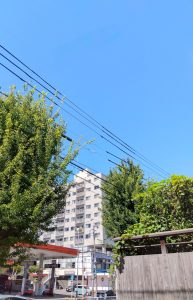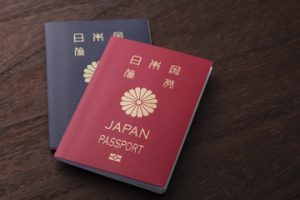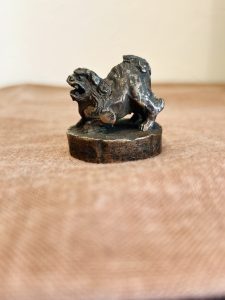帝室技芸員 中井敬所(愛知県名古屋市千種区姫池通 骨董買取 古美術風光舎)
2024.09.23
皆さまこんにちは。スタッフTでございます。
今朝の名古屋は雲ひとつないすっきりとした晴天です。朝、窓からの爽やかな風を感じ、ホッととしながら暖かいコーヒーを飲んでから出勤いたしましたが、いよいよ季節が移り替わってきましたね。

本日はシリーズ化しております「帝室技芸員」についてつぶやきをしようと思っていたところ、「篆刻(てんこく)」という聞きなれない分野が気になりましたので、本日は「篆刻家」中井敬所についてお伝えしようと思っております。まずは「篆刻」とは?。深堀していきますので、少々お付き合いくださいませ。
篆刻(てんこく)とは、「木・石・金などに印を彫ること。その文字に多く篆書を用いるからいう。」とあり、印にする素材に「篆書体」の文字などを彫る行為そのものとされています。
「篆書体(てんしょたい)」とは、中国を統一した秦の始皇帝が六国のバラバラだった文字を統一し、「小篆(しょうてん)」と呼ぶ書体を作りました。この小篆とそこから派生した書体を篆書体と呼びます。
そのため当時の公的な文書では篆書体が使われました。その後、中国から日本に伝わります。歴史上有名な「漢委奴国王(かんのわのなのこくおう)」という後漢(25-220年)の光武帝より贈らた金印は金でできたものです。
また馴染み深い篆書体の例として、日本紙幣にある「総裁之印」の捺印やパスポートの「日本国旅券」と記された印字があります。

ちなみに現在では、篆書だけでなく、隷書・楷書・行書・草書・かなの各書体を刻すことも全て「篆刻」と呼ぶ場合もあります。ほかにも押印した朱肉の跡(印影)と、本体のデザインを眺めて楽しむことも篆刻に含まれます。篆刻は芸術的な面が強いといえます。
また、似た言葉で「落款(らっかん)」がありますが、落款とは、芸術作品(主に書画)が完成したときに書く署名捺印のことで、署名だけ、または捺印だけの場合もあります。
書道はもちろんのこと、絵手紙や年賀状、短冊、ちぎり絵、水彩画、水墨画、色紙などにも押され、篆書体の文字が多く使われますが、行書体、隷書体なども使用されます。書籍に捺す蔵書印も篆刻印の一つです。
たしかに、 年賀状や絵手紙に印が押されていると「むむ。なかなかやるな」と、たいした作品でなくても(すみません)立派に見えたりしますね。
印の起源はかなり古く、5000年前のメソポタミア文明で使われていたと言われています。日本に篆刻が伝えられたのは、江戸時代中期で、主に文人間で使用されていました。書や絵をうまく書くことのできる文人が、自分自身で印を刻するようになったことから、流派としての特色ある印章が生まれました。
その後、鎖国政策が終わりを迎え、中国との交流が盛んになると篆刻界の更なる芸術性が開花し、多くの篆刻家を輩出することに繋がるのです。
その明治時代に活躍したのが中井敬所ですが、そんな彼の略歴を述べますと、
1831年 東京に生まれる
1844年 益田遇所に入門
1868年頃 篆刻家として本格的に活動を始める
1876年 篆刻会結成
1880年 国璽を制作して明治政府に献上
1906年 篆刻家として初めて帝室技芸員に任命される
1909年 胃腸カタルのため東京の自宅にて死去。享年78歳
明治時代の印壇を代表する篆刻家である中井敬所は保守派の印人として知られ、日本における印章学の基礎を築いて『印学の父』とも称されています。
幼少期より叔父にあたる三世浜村蔵六について篆刻を学び、次いで益田遇所に師事して研鑽を重ねます。二人の師は共に、江戸時代の儒学者で国内の印章制度を確立して『印聖』とも称させた高芙蓉の教えを受け継いだ、江戸の篆刻界を代表する人物でした。
22歳で中井家の養子になり、家業であった鋳金に従事しますが、明治維新以降、中国の篆刻について熱心に学び修錬を積んだのち、中国篆刻家の作風の流れを大きく受けた作品の制作に取り組みます。のちに「菡萏(かんたん)居社」を設立し、岡本椿所、郡司楳所、増田立所、井口卓所、など多くの門人に篆刻の技術を伝授しました。
このほか、国の印章である国璽を刻して明治政府に献上したほか、宮内省に設置された宝物取調局査係や内国勧業博覧会審査官などを歴任し、75歳で篆刻家として初の帝室技芸員に任命されました。
日本はデジタル技術が発展した今も、筆での署名及び印鑑での契約の習慣が続いています。またそれに付随して印鑑の数を数種類持っている事も日本ならではと言われています。
中井敬所による篆刻及び日本印象学についての資料は残念ながらあまり見当たらないようですが、中国や国内の古印の研究にも尽力し、日本の印章学の基礎となる優れた著作を遺しています。
印章が日本の文化として続いていけば中井敬所の功績にも、これからより光が当たるかもしれません。
ではでは、また。

Hello everyone. This is Staff T.
It is a clear and cloudless day in Nagoya this morning. I felt the fresh breeze from the window this morning and drank a cup of warm coffee before going to work.
Today, I was going to write about “Imperial Household Artists,” which has become a series of tweets, but then I became curious about the unfamiliar field of “seal engraving,” so today I am going to tell you about “seal engraver” Keisho Nakai. First of all, what is “Tenkoku”? Please bear with me for a moment as I delve deeper.
Tenkoku means “to engrave a seal on wood, stone, or gold. It is called “Tenkoku” because many seal scripts are used for the characters. It is said to be the act of engraving “seal style” characters on the material to be used as a seal.
The term “seal style” refers to the typeface called “small seal” created by Qin Shi Huangdi, the first emperor of the Qin Dynasty, who unified China by unifying the disparate characters of the six kingdoms. This small seal and the typefaces derived from it are called seal scripts.
Therefore, the seal script was used for official documents at that time. Later, it was introduced from China to Japan. The historically famous gold seal presented by Emperor Guangwu of the Later Han Dynasty (25-220) named “King Kannowanokoku” was made of gold.
Familiar examples of seal script include the “President’s seal” stamped on Japanese banknotes and the “Japan passport” printed on passports.
Incidentally, nowadays, engraving not only in seal script, but also in clerical, standard, running, cursive, and kana scripts is also sometimes referred to as “seal engraving. In addition, enjoying the design of the body of the seal and the mark of the red ink (seal impression) is also included in the seal engraving process. It can be said that seal engraving has a strong artistic aspect.
A similar term is “rakkan,” which refers to a signature and seal written when a work of art (mainly calligraphy and paintings) is completed.
In addition to calligraphy, it is also stamped on picture letters, New Year’s greeting cards, strips of paper, chigiri-e, watercolor paintings, ink paintings, colored paper, etc. Although seal script characters are often used, gyosho and clerical script characters are also used. Kurasho seals, which are stamped on books, are also seal impression seals.
Indeed, when a seal is stamped on a New Year’s greeting card or a picture letter, one may say, “Mm-hmm. It is true that when a seal is stamped on a New Year’s greeting card or a picture letter, it looks splendid even if it is not a great work of art.
The origin of seals is quite old and is said to have been used in the Mesopotamian civilization 5,000 years ago. It was in the middle of the Edo period (1603-1867) that seal engraving was introduced to Japan, and was used mainly among literati. Literati who could write and draw well began to carve seals themselves, giving birth to distinctive seals as a school.
Later, as the policy of national isolation came to an end and exchange with China flourished, further artistic development in the seal engraving world blossomed, leading to the production of many seal engravers.
After that, Nakai Keisho was active in the Meiji Era, and here is a brief history of him,
1831 Born in Tokyo
1844: Introduced to Masuda Gyosho
Around 1868: Began full-scale activities as a seal engraver
1876 Formed a seal engraving society
1880 Produced the National Seal and presented it to the Meiji Government
1906: Appointed as the first seal engraver to be appointed as an Imperial Household Artist.
1909: Died of gastrointestinal catarrh at his home in Tokyo. He was 78 years old.
Nakai Keisho, a seal engraver representing the seal world of the Meiji era, was known as a conservative seal engraver and is also called the “father of sealology” for laying the foundation of sealology in Japan.
He learned seal engraving from his uncle, Hamamura Zoroku III, from his childhood, and then studied under Masuda Gyosho. Both masters were representative figures in the seal engraving world of Edo, having inherited the teachings of Gao Fuyou, a Confucian scholar of the Edo period who established the domestic seal engraving system and was also called “Seal Sage”.
At the age of 22, he was adopted by the Nakai family and engaged in the family business of metal casting, but after the Meiji Restoration, he studied Chinese seal engraving with great enthusiasm, and after accumulating training, he began to produce works that were greatly influenced by the style of Chinese seal engravers. Later, he established “Kantan Company” and taught seal engraving techniques to many of his students, including Okamoto Tsubakisho, Gunji Umesho, Masuda Tatejyo, Iguchi Takusho, and others.
In addition, he engraved the national seal and presented it to the Meiji government. He also served as an inspector of the Treasure Collection Bureau established by the Ministry of the Imperial Household and as an examiner for the National Industrial Exhibition, and was the first seal engraver to be appointed as an Imperial Artist at the age of 75.
Even with the development of digital technology in Japan, the custom of signing contracts with a brush and using a seal continues. It is also said that having several types of seals is unique to Japan.
Unfortunately, there are few materials on seal engraving and Japanese impressionology by Nakai Keisho, but he has devoted himself to the study of ancient seals in China and Japan, and has left behind some excellent works that will serve as the basis of Japanese sealology.
If seals continue to be a part of Japanese culture, Nakai Keisho’s achievements may be illuminated in the future.
See you soon.
*******************
ご実家の整理やお片付けなどをされている方のご相談などが多くございます。
お片付けなどくれぐれもご無理のないようになさってくださいませ。
風光舎では古美術品や骨董品の他にも絵画や宝石、趣味のお品など様々なジャンルのものを買受しております。
お片付けをされていて、こういうものでもいいのかしらと迷われているものでも、どうぞお気軽にご相談下さいませ。
また風光舎は、出張買取も強化しております。ご近所はもちろん、愛知県内、岐阜県、三重県その他の県へも出張いたします。
なお、毎月21日の持込鑑定会では無料鑑定・買取・ご相談など、ご予約なしで承っております。
ご近所の皆さま、ご遠方のみなさまも、お気軽にお越しくださいませ。
まずは、お電話お待ちしております。
愛知県名古屋市千種区姫池通
骨董 買取【古美術 風光舎 名古屋店】
TEL052(734)8444
10:00-18:00 OPEN
#出張買取#骨董#古美術#骨董品#絵画#版画#茶道具#刀剣#彫刻

